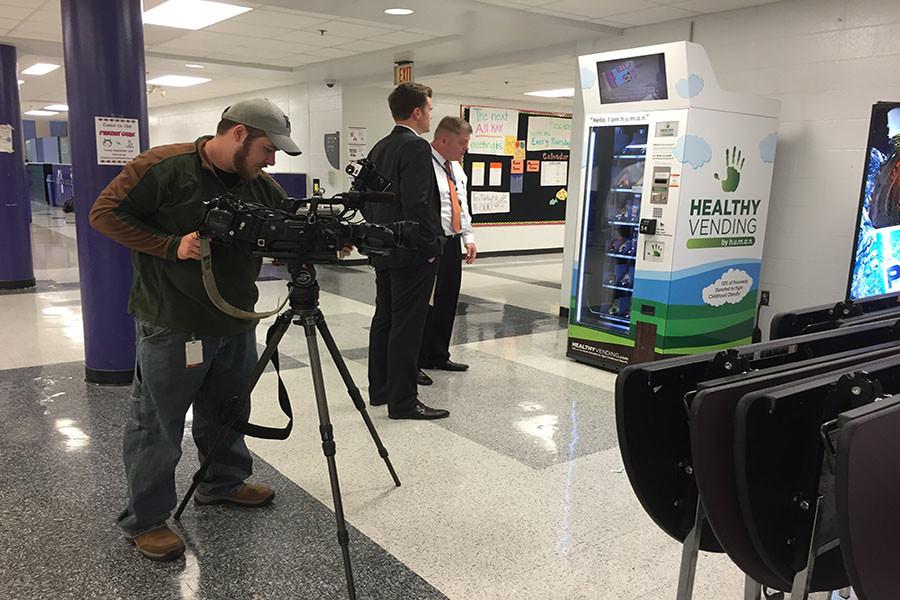Congress plans to reconsider school lunches, news channel visits BVNW
Local news station 41 Action News came to BVNW today to film for a series about the potential changes in school lunch regulations.
September 22, 2015
School lunch regulations are under consideration in Congress. NBC-affiliate, 41 Action News, came to BVNW today for their series about school lunches.
“School lunches are a really hot topic right now, nationally,” reporter Justin Wilfon said. “There [have been] relatively new federal regulations for a few years now. Schools have tried to adapt to those as best as they can. Now…Congress will decide whether to continue the regulations or to tweak them or get rid of them. So we thought it was a good time to go into our local schools and see what they’re serving for lunch basically.”
Wilfon said there was not a specific reason 41 Action News focused on BVNW for their story; he said they wanted to cover a school in the Blue Valley district because the district is one of the largest in the area. From there, the Blue Valley district selected BVNW specifically.
Wilfon said, from what 41 Action News has seen, the number of options in school lunches vary widely between high school and middle school. However, the major difference between BVNW and other high schools in the area was how the vending machine is turned off during school hours.
“One of the things that we are shooting here are the soda machines because it’s turned off during school hours and many high schools in the area still do allow their kids to have soda,” Wilfon said.
Mistie Hollingsworth, the BVNW food service manager, who has worked for the district for 26 years, said what is offered in the cafeteria is controlled by the state. She said the district sets the menu for the schools.
“We’re mandated by the state so we have to do whatever they tell us to do,” Hollingsworth said. “They look at calories; they look at nutritional values; they set certain standards that we have to meet every week per child…Everything has to be within their range of what they think is healthy.”
Hollingsworth said there are specific standards set for different food options. She said certain snacks can be only certain calories and drinks have to be zero calorie or sugar free. Through the years, Hollingsworth said she has seen Blue Valley’s lunch regulations and options evolve significantly over the years.
“Through the years I’ve seen a lot of changes,” Hollingsworth said, “but it’s all necessary.”
Hollingsworth said that she hopes school cafeterias are provided more leniency with the lunch regulations because it leads to waste.
“Hopefully [Congress] will do us good us this year and won’t cut us back anymore,” Hollingsworth said. “Kids are wasting stuff because they have to take it. So we would like to see that change.”
Currently, Hollingsworth said students are required to get a certain proportion of different foods to make a meal.
“It does not make a meal unless it contains fruit or vegetables and not all kids eat fruit or vegetables,” Hollingsworth said. “They make you take certain amounts in order to qualify for that meal. If they were to change it around a little bit, then maybe there would be a little less waste.”
Although the cafeteria provides a variety of healthy options, Hollingsworth said ultimately, students have to determine what choice they want to take.
“We provide the nutrition and the choices, but they have to make the right choice,” Hollingsworth said. “They can decide to get five pieces of pizza and call that lunch or they can get a piece of pizza, a [salad], an apple and a banana and call that lunch. It’s up to you guys to make the right choices.”
Blue Valley’s Director of Food and Nutrition Services Charles Rathbun, who Wilfon also interviewed, said the district’s food is funded by the federal and the state government. Rathbun said with this funding there are specific requirements for students in order for it to qualify for a school meal. At the start of the 2012-13 school year, Blue Valley changed its guidelines for school meals. Rathbun said one major change was that students were required to take a half cup of fruits and/or vegetables in order to have their lunch qualify as a school meal.
“We offer a wide variety of fruits and vegetables with the hope that students will make that choice to get that half a cup to make that an easy transition from the old guidelines,” Rathbun said.
Like Hollingsworth, Rathbun also said there was an increase of waste as a result of the new guidelines.
“I would definitely say we saw an increase in waste,” Rathbun said. “But what our hope is that students are consuming [the fruits and vegetables]. That’s probably been a bigger challenge for us. We don’t want to throw it away anymore than you do as a student. If we can offer things that students can consume that’s a positive for everyone.”
However, Rathbun said the school meal is set up so that it is more economical to include the fruits and vegetables to make it a school meal.
“The way our school meal is set up it’s actually more economical to take advantage of the fruits and vegetables we have available to make a school meal,” Rathbun said. “It is to the benefit of the students to find what they like and make it a school meal.”
The deadline for Congress to make changes to the current school food guidelines is Sept. 30. Rathbun said he hopes there is discussion of school districts difficulties with the current guidelines. He also said additional funding may be necessary to adjust to the rising cost of food.
“I think there needs to be a full understanding of the challenges that school districts are facing with the rising cost of foods and how the funding might be structured a little bit different,” Rathbun said. “It would probably be more helpful for us to make sure we’re still able to offer and continue to expand what we do offer to students.”
The series started tonight and will air at 4 p.m. for the next three days. Blue Valley was not part of the show tonight but will be featured tomorrow and/or Thursday, according to Wilfon.






